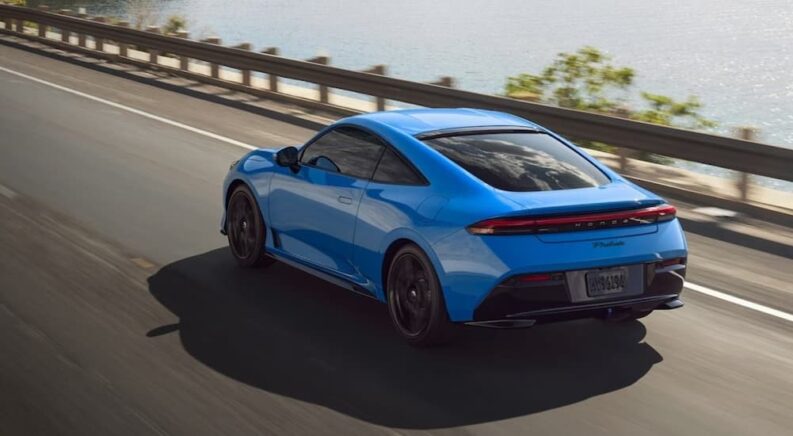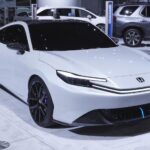What do you get when you combine the Honda Civic’s award-winning hybrid engine with the Civic Type R’s innovative suspension? The answer is the Honda Prelude, a sporty new coupe that steps in to fill the hole left by the dearly departed two-door versions of the brand’s Civic and Accord models. This sport compact actually dates back some 50 years, but was shelved in 2001 as Honda shifted its focus to SUVs and sedans.
The Prelude now returns with a vengeance for the 2026 model year, which is sure to lift the spirits of those seeking an eco-friendly ride that also prioritizes style and performance. While we wait for the 2026 Prelude to arrive at your local Honda dealer, we thought it would be a great time to explore Honda’s triumphant return to the sport compact segment. We’ll touch on the Prelude’s long history as Honda’s first true performance model for the U.S. market, trace the car’s evolution, and explore the unique design process that led to the creation of the new sixth-generation model.
A Quick Prelude
First hitting the market in 1978, the original Prelude marked a significant departure for the Honda brand. The Japanese automaker had quickly carved out a niche in the U.S. market with the affordable, efficient Civic, and soon expanded the lineup with the larger, more luxurious Accord. The new Prelude fell somewhere in the middle, adopting the Civic’s smaller size while borrowing the 1.8L engine from the midsize Accord. The combination proved effective, giving Honda a new sporty option that showcased its penchant for performance-focused design. The second-generation Prelude doubled down on that athleticism with the debut of the Prelude Si. Short for “sport injection”, the upgraded Prelude leveraged direct fuel injection technology to give its upgraded 2.0L engine a little extra pep in its step.
The third-generation Prelude hit the market in 1988 and introduced a new four-wheel steering system dubbed 4WS. The system allowed the front and rear wheels to turn in opposite directions at lower speeds for increased maneuverability. However, high-speed scenarios were where 4WS really got the chance to shine. By enabling the front and rear wheels to turn in the same direction, 4WS was able to improve the Prelude’s stability and responsiveness through the corners for a safer, more predictable ride. The fourth-generation model kept the innovations coming with the first double overhead cam (DOHC) version of the brand’s iconic VTEC variable valve timing system. Improving both performance and efficiency, the DOHC-enabled VTEC engine saw the Prelude pump out 190 hp and 158 lb-ft. of torque.
Honda concluded the Prelude’s initial run with the fifth-generation model, which was produced from 1997 to 2001. The 2.2L VTEC engine was now rated for 200 hp and was paired with a torque-vectoring system that enhanced the coupe’s traction in an effort to reduce both understeer and oversteer when cornering. The design worked well, and the Prelude rose to the top of the Car and Driver list of the best-handling vehicles under $30,000 in 1997. A “spirited, predictable, and utterly unflappable” ride allowed the Prelude to claim the title and best the likes of the BMW 3 Series, Chevy Camaro, and Mazda Miata.
Gliding Into the Future
It’s easy to tell when a car has been crafted with love and dedication. While some models stick to a well-worn formula or follow emerging trends, the new Prelude takes an entirely different approach to provide drivers with an exciting new option in the sport compact segment. The project was spearheaded by a man with longstanding ties to the coupe, Honda Creative Director Hideaki Uchino. “The Prelude is also a car that changed my life,” says Uchino, and he’s not kidding. Uchino caught the attention of his future wife behind the wheel of a 1991 Prelude. She was immediately impressed by the vehicle’s style and performance. This connection made Uchino the perfect man to lead the Prelude project after a long career spent crafting other popular Honda models like the Civic, NSX, and Acura Integra.
For Uchino, designing the revived Prelude was all about looking to the past while keeping one eye on the future. The designer purchased a third-generation Prelude as part of the research and development process while also meeting with Gen Z drivers to learn more about their evolving automotive expectations. “It’s been about 25 years since the previous fifth-generation Prelude, and in that time there have been many changes in people’s values, lifestyles, and the global environment,” says Uchino. “If people have changed, cars must change too.”
The Prelude team turned to the skies to gain inspiration for the new sport compact, specifically the motorless aircraft known as gliders. Some 30 employees participated in a glider flight experience, soaring through the air to flesh out a new unifying concept that would inform the Prelude’s design. The team eventually landed on the theme of “Unlimited Glide”, which Honda describes as “a worldview in which owning a car expands one’s possibilities infinitely.”
“That feeling of expanding the body, as if becoming one with the flow of the wind, was then incorporated into the driving and design aspects. While retaining the quiet, powerful appearance without adding excessive ornamentation, we took on a new challenge by adding a glider-like elongation to the front and a ground-kicking strength to the rear,” says Uchino.
The glider might seem like an odd choice when seeking inspiration for a new performance-minded model. After all, the airplane can’t even move under its own power. However, Honda product designer Norito Onuma says there’s much to learn from the humble glider.
“Gliders are unpowered, but by using updrafts to their advantage, they can rise multiple times and have the potential to fly at speeds in excess of 200 km/h,” says Onuma. “And in the process, they are vehicles that offer the joy of searching for the perfect spot to glide comfortably. This unique sense of ease and tension is exactly what we were aiming for with the new Prelude.”
The Unlimited Glide concept is reflected in the Prelude’s exterior, which employs a front motif that thrusts forward to evoke the lightness of the moment when the glider first lifts off the ground. The rear end takes the opposite approach, featuring a strong, stable design firmly anchored on the ground.
“The design was created through repeated trial and error in order to simultaneously convey the aesthetics of both inclusion and liberation that a glider possesses,” says Onuma. The concept also carries over to the interior, where drivers will find a minimalist cabin that’s defined by its horizontal lines, subdued colors, and lack of decoration. Designed to allow drivers to focus on the road, the spartan approach creates a more immersive driving experience.
Unlocking a New Era Of Performance
Under the Prelude’s hood, drivers will find a familiar setup that’s been lifted from the Civic Hybrid. A 2.0L I-4 engine is paired with two electric motors to give the Prelude 200 hp and 232 lb-ft. of torque. The powertrain might not blow drivers away in terms of raw numbers, but true performance isn’t measured solely in terms of hp and torque.
The Prelude’s biggest advantage comes down to its sophisticated suspension. Honda has graced the sport compact with the same dual-axis front suspension geometry as the Civic Type R, allowing drivers to make the most of the Prelude’s mill. Front-wheel drive models like the Prelude are susceptible to torque steer, which is the tendency of a vehicle to pull to one side when accelerating at high speeds. This can cause uneven torque distribution and a less-than-predictable ride. Honda has engineered around this issue with the Prelude’s innovative dual-axis front suspension geometry. The Prelude could even feature the Type R’s adaptive dampers, which would have a noticeable effect on the coupe’s comfort and handling, but it will definitely include the souped-up Civic’s Brembo front brakes and share its wheelbase.
The Prelude also serves as a showcase for Honda’s brand-new Linear Shift Control (LCS) technology. There are lots of enticing advantages to the hybrid approach, but the Prelude’s lack of a traditional transmission might cause the coupe to feel a little foreign to some drivers. Like many hybrids, the Prelude employs a direct-drive system that lacks the hallmark shifting feel of a traditional transmission. While this does have some benefits in terms of efficiency, the lack of feedback can be a little jarring and create a bit of a disconnect between the driver and their vehicle. Honda has addressed this issue by using the generator motor to adjust the engine’s speed in order to mirror the accelerator input and current speed, simulating the sounds and revs that come with the typical shift without sacrificing any fuel economy.
LCS, along with a new S+ Shift mode, will improve on the formula by providing drivers with extra control in the form of paddle shifters that can be used to offer an experience more akin to a manual transmission. According to Honda, LCS and the S+ Shift mode will improve the Prelude’s feel by upping “the efficiency of a high-performance engine and high-output motor, finely controlling engine RPM across all acceleration and deceleration ranges based on driving conditions.” It will feature an active sound controller and a handy dashboard gauge, providing drivers with audio and visual feedback.
A Sign Of Things To Come?
The Prelude represents both a bold new direction for Honda and a nod to the past. By reviving one of its most beloved nameplates, Honda is giving a new generation of drivers a chance to experience the sort of excitement a sport compact can provide. The Civic Si and Type R have been carrying that torch for the last few decades, but the Prelude’s two-door design brings the segment back to its roots while incorporating innovative new technology like a hybrid engine, dual-axis front suspension geometry, and Linear Shift Control. The Prelude’s eye-catching exterior styling speaks for itself, but Honda has exercised plenty of restraint to keep the cabin from feeling too cluttered, with a pared-back approach that’s designed to soothe the mind no matter where the road might take you. Hybrid technology is unlocking a new era of performance design, and the Honda Prelude serves as a great example of everything there is to love about the electrified approach.




